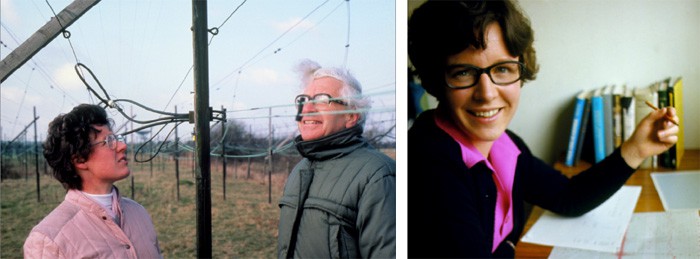Sarah Tesh and Jess Wade describe Jocelyn Bell Burnell’s highs and lows, as revealed in her recent IOP President’s Medal lecture
When Jocelyn Bell Burnell discovered pulsars 50 years ago, in 1967, she was not asked about her groundbreaking finding, but how she compared in height to Princess Margaret. Unfortunately, this was not the first time, nor the last, that she would face such sexist attitudes. Bell Burnell persevered, however, and has gone on to become a fellow of the Royal Society, a dame and a multi-award-winning scientist – although most controversially, not a Nobel prize winner.
In July Bell Burnell was presented with the prestigious President’s Medal of the Institute of Physics (IOP) “for her outstanding contributions to physics through pioneering research in astronomy, most notably the discovery of the first pulsars, and through her unparalleled record of leadership within the community”. The award, which is given at the discretion of the IOP president – currently Roy Sambles – was presented at the University of Birmingham in the UK as part of the International Conference on Women in Physics. Rather than giving an Oscars-style acceptance speech, Bell Burnell delivered a fascinating lecture, outlining her career in physics as well as the obstacles she had to overcome along the way. As her story would reveal, she faced much bias and stereotyping, but she refused to yield to society’s expectations.
Success in spite of bias
It was at a young age that Bell Burnell first had to fight for the right to learn science. At her school in Northern Ireland, only boys were taught science and girls were instead given cooking lessons – after all, they were going to get married and raise a family, not study or have a career. To say Bell Burnell was unhappy about this would be an understatement. Her parents “hit the roof” and, soon after, she and two of her female friends joined the boys’ science class.
It did not take Bell Burnell long to realize that of all the sciences, she found physics the most interesting. She was “not so keen” on chemistry, and biology was “boring”, but she found physics fascinating and came top of the class, going on to study the subject at the University of Glasgow and graduating in 1965.
At this time it was traditional for male students to cat-call, heckle and stamp their feet when a female student entered a lecture theatre – something Bell Burnell found herself facing alone in the final years of her undergraduate degree as the only woman left on her course. Undeterred, she went on to earn a PhD at the University of Cambridge. She was passionate about astronomy but also loved a good night’s sleep, and so optical astronomy – which involves working a lot at night – did not appeal. Instead, she opted for radio astronomy.

As part of her PhD, Bell Burnell and five colleagues built a radio telescope on a patch of land two-and-a-half times the size of a football pitch. It took two years to construct and required a lot of manual labour. Her colleagues assumed she would be too “girly” to do such things – “It’s not suitable for a woman, you’re working up a ladder all the time,” she was told. But Bell Burnell had other ideas – she was too hands-on for that attitude to remain in place for long – and she quickly got stuck into the construction work.
After the team finished the telescope, its operation became Bell Burnell’s responsibility. Data collection was yet to be digitized and so a complete scan of the sky took four days and required 120 m of paper. Bell Burnell’s six-month period of observation generated 5.3 km – all of which she analysed by hand. In the autumn of 1967, her attention to detail identified a mysterious trace – a 0.5 cm-long “scruff” of signal showing a series of regular peaks in luminosity. This bugged her. “I just couldn’t understand it,” she recalls. When she detected the signal again in the same patch of sky, her brain jumped into gear. “You’ve seen this somewhere before, haven’t you?” she asked herself. After digging through shoe boxes full of data, she concluded that the signal was neither a scintillating source, nor man-made interference. Instead, the near-perfect regularity of the peaks, which repeated every one-and-a-third seconds, led to her noting “LGM-1: Little Green Men?” in the margin of her lab book.
It would soon become clear that the little “scruff” was the first ever detection of a pulsar – a rotating neutron star that emits a regular ticking signal of radio waves. “It was a totally unexpected result that caused a major reappraisal within astrophysics,” says Bell Burnell. In fact, her supervisor Antony Hewish initially refused to believe she had found a pulsar and was convinced the signal was a product of either humans or aliens. Bell Burnell and her colleagues tested for all such possible signals. If it were aliens, the pulses would show a Doppler shift as they orbited their own Sun – which they didn’t. The pulses couldn’t be made on Earth because they kept sidereal time – a timescale based on Earth’s rotation relative to stars other than the Sun. Another observing team on a different telescope also detected the pulsations, ruling out instrument error. With these other possible sources eliminated, in January 1968 the Cambridge team – with Hewish as lead author and Bell Burnell second – submitted a paper to Nature, announcing the “Observation of a rapidly pulsating radio source” (217 709).
In Bell Burnell’s mind, the discovery was not a consequence of her ingenuity or skill, but rather it was a result of her “imposter syndrome”. She didn’t feel bright enough to be at Cambridge and had struggled to find her place among her predominantly male colleagues, who were described by some as “frequently in error, but never in doubt”. She therefore worked like crazy to avoid being thrown out, and refused to give up.
Test of tenacity
In the press coverage that followed the finding, Bell Burnell found that sexist attitudes spanned beyond academia. In one photo shoot she was told to pose triumphantly – “Look happy dear, you’ve just made a discovery!” And despite her being listed as second author on the Nature paper, the press was more concerned with her love life than her scientific accomplishments. “Initially, the discovery didn’t have a major effect on my career… except to help me survive,” she says.
There was also the matter of the Nobel prize, which even in the 1970s sparked controversy. Hewish and his colleague Martin Ryle were awarded the Nobel Prize in Physics in 1974 for the pulsar discovery, while Bell Burnell did not get recognition. While many people nowadays assume that this was down to her gender, she in fact attributes it to her being a student at the time. She doubts, however, that such an injustice could happen again, pointing out that the 1993 Nobel prize for finding a binary pulsar went to Russell Alan Hulse, who was a student at the time of the discovery, along with his supervisor Joseph Hooton Taylor Jr. “At least they don’t make the same mistake twice,” she says.

Continuing her groundbreaking research, Bell Burnell went on to find three more pulsars. Her friends were more interested in her love life, though, and when she got engaged to be married between pulsars two and three, this was all they spoke about. Bell Burnell wore her engagement ring to the lab, but later regretted it, as she says it was seen as a signal to the scientific community that she was quitting her research: “Society expected young women to get married, not make major astronomical discoveries!”
When Bell Burnell became pregnant, it presented new challenges to an already difficult research career. She explains that there was a consensus that “if mothers work, the children will become delinquent”, and no-one quite understood why she wasn’t delighted at the prospect of becoming a housewife. “You’ve got a husband, a new baby and a new house and you say you’re bored – what’s wrong with you?” another woman once said to her.
But attitudes in general were changing and Bell Burnell believes her generation experienced a turning point; for the first time, women could have successful professional careers alongside running a family. It was tough, though, and a woman’s career was not deemed as important as a man’s. Once, when her son was taken ill at school and the teachers couldn’t get hold of Bell Burnell because she was working at a telescope, they turned to him and asked “You’re not so ill we have to disturb daddy are you?”
Bell Burnell’s career, which “felt like snakes and ladders”, has spanned right across the academic spectrum, just as her research career has spanned the electromagnetic spectrum. She has been a researcher, a university lecturer, a tutor, a manager, a professor, a head of department, a dean, a principal researcher, an outreach ambassador and IOP president.
Lessons still to learn
Despite her own success, Bell Burnell is concerned that “younger women think the battles have all been fought”. The statistics are still bad – women are still under-represented in physics, and it gets worse in senior positions, where women progress more slowly than men and are less successful when they put in grant or job applications.
Bell Burnell describes how the attitude for solving this problem is often “Fix the women!” – make them braver, give them special training to address their inability to communicate and so on. However, this assumes the problem is with women, not with the scientific community or society in general. Bell Burnell notes that, while individuals may be fine, flawed institutional structures and policy can nurture bias.
To this end, she identified that universities would only become more gender balanced if they were competing for something. This revelation led to the creation of Athena SWAN – the world’s first award scheme to recognize commitment to women’s academic careers. Bell Burnell was pivotal in establishing the scheme in 2005, which is a gender-equality charter for university departments that challenges people to address and stop institutional sexism. But, she says, there is still a long way to go.
Bell Burnell concluded her IOP President’s Medal lecture with the infamous quote by Laurel Thatcher Ulrich: “Well-behaved women seldom make history.” This is a statement that perfectly describes her fight against the expectations of society and her career that continues to inspire both men and women today.
-
- The Jocelyn Bell Burnell Award Event, which recognizes an outstanding very early career female physicist, will be held on 11 October in London. For more details see ow.ly/UIVC30dZlhV
Sarah Tesh is features editor of Physics World (click link below for full bio) and Jess Wade is a postdoc at the Centre for Plastic Electronics at Imperial College London, UK, @TeshSarah and @jesswade




